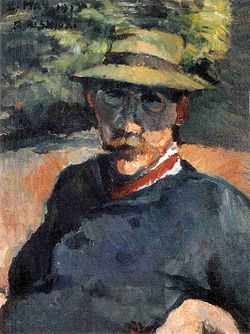Bernard Leach
Bernard Howell Leach ( Japanese リ ー チ ・ バ ー ナ ー ド , Rīchi Bānādo ; born January 5, 1887 , Hong Kong ; † May 6, 1979 in St Ives , Cornwall ) was a British potter with close ties to Japan and author of books on pottery .
Life
Leach was born in Hong Kong, the son of a lawyer. His mother died shortly after his birth, so he was brought to Japan, where his grandparents, who lived in Kyoto, took him over for some time. In 1890 his father remarried and young Bernard returned to Hong Kong. In 1887 he moved to Singapore, where his father was appointed judge. Eventually an Uncle Bernard took him to England, where he graduated from high school near Windsor.
From 1903 Leach attended the Slade School of Fine Art and studied under Henry Tonks . After his father's death in 1904, he began an apprenticeship at a bank, but then took up art again, at the London School of Arts . There he studied etching under the direction of Frank Brangwyn and began to occupy himself with Japan , inspired by the books Lafcadio Hearns . So he made friends with Takamura Kōtarō , who also studied at the art school, expanded his knowledge of the country and decided to work there.
April 1909 Leach arrived in Nagasaki and traveled on to Tokyo. There he moved into a house in the Sakuragi-cho ( Ueno ) district and began teaching etching . He made contact with members of the artist group Shirakaba ("The Birch"), editor of the eponymous magazine Shirakaba , met the writer Mushanokōji Saneatsu , the folklorist Yanagi Sōetsu (1889-1961), the writer Shiga Naoya and others. His students included Kishida Ryūsei , Satomi Ton and Kojima Kikuo.
In 1910 a friendship began with Tomimoto Kenkichi (1886–1963), with whom Leach made pottery from 1911 under Ogata Kenzan VI. studied and graduated with a diploma that year. From 1913 Leach designed cover pages for the Shirakaba and another magazine, "Fyūzan". The first exhibition of his ceramics followed in Tokyo in 1914. Then his admiration for the Prussian philosopher and art expert Alfred Westharp in Beijing led him and his family to move to Beijing in 1915.
In 1916, Yanagi visited Leach in Beijing and urged him to return to Japan. Leach returned and bought Kenzan's kiln and rebuilt it on Yanagi's property in Abiko, near Tokyo. In 1917 Leach Tomimoto visited Kyōto, in 1919 there was a first meeting with Hamada Shōji in Abiko. When Leach's kiln was destroyed, the painter Kuroda Seiki offered him his property for a new kiln.
In 1920 Leach had a solo exhibition in Osaka, which he combined with a visit to the potter Kawai Kanjirō (1890-1966). That year Leach returned to England with Hamada, where he set up a pottery in St. Ives, Cornwall. With financial support from Margery Horn, Leach built the first furnace in Europe with rising combustion chambers ( hanging furnace ), as they were typical for East Asia.
After exhibitions in England in 1921 and 1922, a solo exhibition in Tokyo followed in 1923, and Shirakaba published a special edition about him. That was also the year when the first student came to Leach. In 1929 Yanagi and Hamada, who had returned to Japan in 1923, visited Leach in England. Leach becomes an elected member of the Kokugakai ( Association of National Painting ).
Further exhibitions follow. In 1933 the Kokugakai held a retrospective in Japan, and the Kōgei magazine issued a special issue. In 1934 Leach visited Japan, met his old friends and used their stoves for his own work. In 1949 Leach exhibited in Scandinavia, and in 1950 he spent four months in the USA. In 1953/54 he was back in Japan, traveling around the country and working on various ovens. In 1961 there was a major retrospective in London and again a visit to Japan, where he participated in the opening of the ceramics building of the Ohara Museum in Kurashiki .
In 1962, back in England, he was appointed Commander of the Order of the British Empire (CBO). In 1964 he attended the meeting of Japanese artisans in Okinawa . He used the stay to study the classical Japanese artists such as Ogata Kōrin and Ogata Kenzan . He also began to translate selected writings into English by his friend Yanagi, who died in 1961. In 1969 the tenth trip to Japan followed, which was followed by more.
In 1977 a retrospective took place at the Victoria and Albert Museum : "The Art of Bernard Leach". Leach died in 1979 at the age of 91. In 1980 a major commemorative exhibition was held in Japan on loan from the British Museum and collectors.
gallery
Publications (selection)
- A Potter's Book (1940)
- The Leach Pottery 1920-1946 (1946)
- A Potter's folio (1951)
- A Potter in Japan (1960)
- The Unknown Craftsman (English translation of Yanagi's writings) (1972)
- Hamada: Potter (1975)
- A Potter's Challenge (1976)
Remarks
- ↑ Kenzan VI. (1851–1923) was the sixth successor to the painter and potter Ogata Kenzans (1663–1742), following the Japanese teacher-masterclass principle .
- ↑ paraphrase from French "fusain" (charcoal drawing)
literature
- Ohara Museum of Art & Asahi Shimbun (ed.): An Exhibition of the Art of Bernard Leach. Asahi Shimbun, 1980. (Japanese).
Web links
| personal data | |
|---|---|
| SURNAME | Leach, Bernard |
| ALTERNATIVE NAMES | リ ー チ ・ バ ー ナ ー ド (Japanese, romanization); Leach, Bernard Howell |
| BRIEF DESCRIPTION | British potter closely related to Japan and author of books on pottery |
| DATE OF BIRTH | January 5, 1887 |
| PLACE OF BIRTH | Hong Kong |
| DATE OF DEATH | May 6, 1979 |
| Place of death | St Ives |





